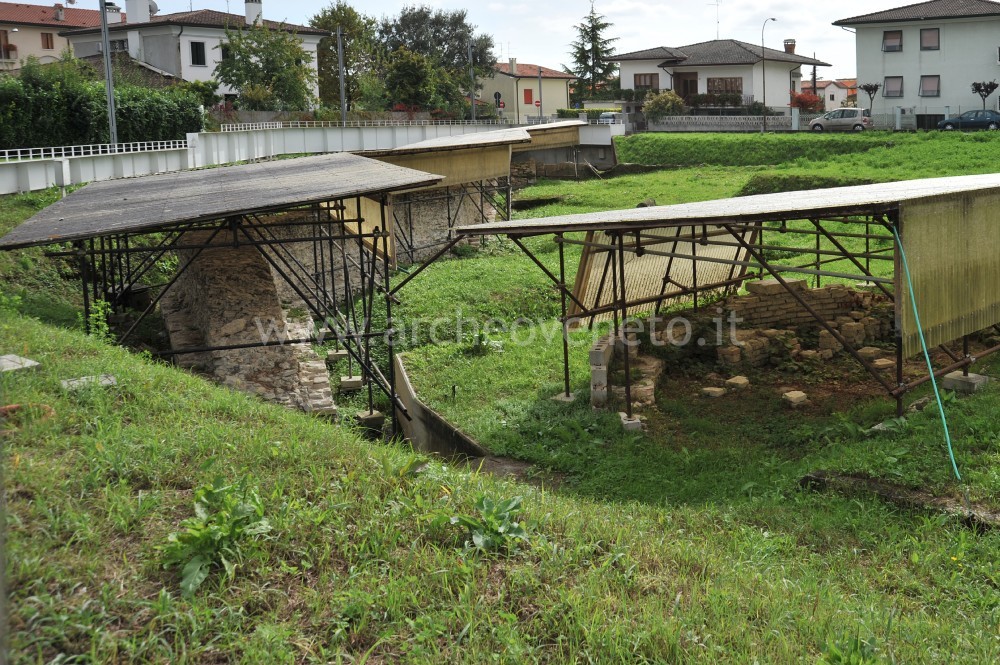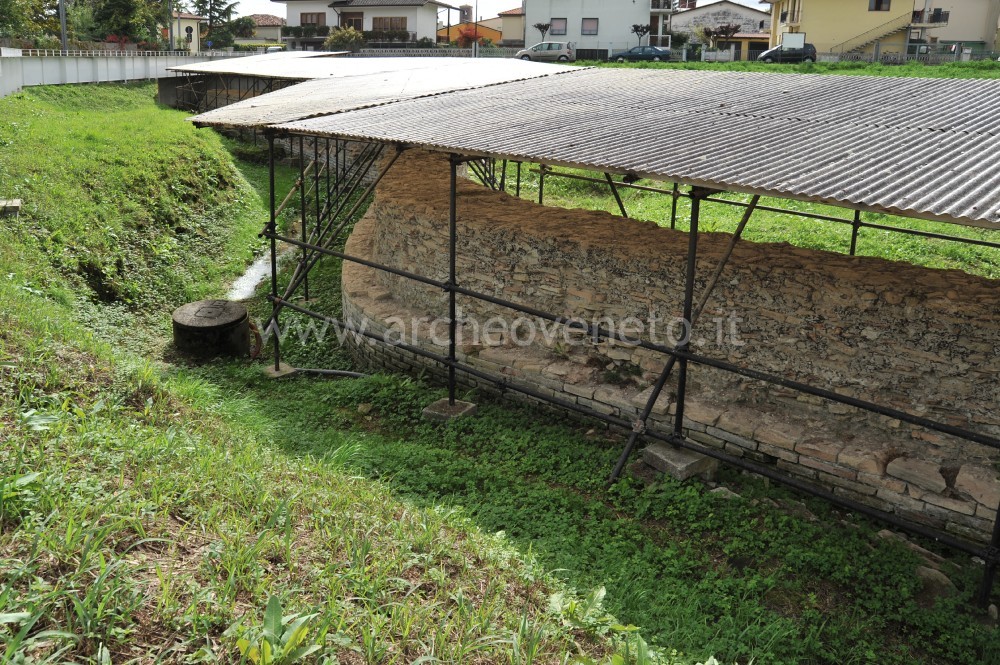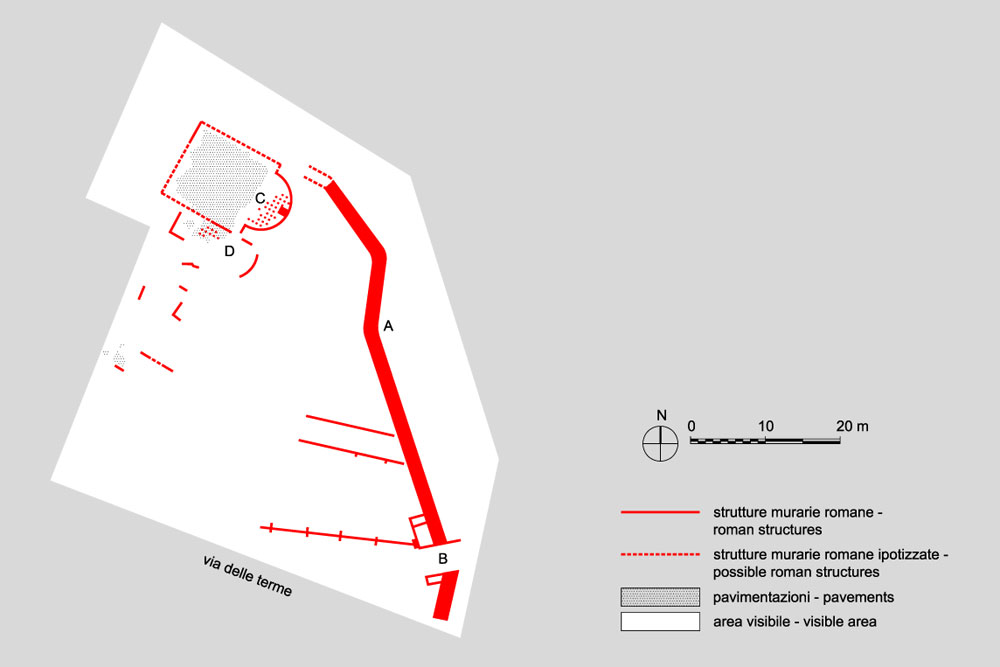|
|
File
Roman city walls and baths in “Via delle Terme” – Concordia Sagittaria
|
| Via delle Terme 21-60 – 30023 Concordia Sagittaria (VE)
|
  |
|
Summary

The archaeological area in the street “Via delle Terme” preserves the remains of the north-eastern part of the city walls and of a city gate of Augustan times, of residential buildings dating back to the I century A.D. and of a public bath of the I II – III century A.D.
History of research
After the first excavations were carried out on the occasion of a construction project, systematic researches were pursued from 1981 to 2001 by the General Direction for Archaeological Heritage in the Veneto region.
Urban and geographical context
Concordia Sagittaria is located in the north-eastern Veneto plain, in a territory surrounded by the Tagliamento river on the east and the Livenza river on the west. The main river of the city is the Lemene, which flows from the springs strip, passes through the centre of Concordia and finally flows into Valle Zignago, the northernmost extreme of the lagoon in Caorle. This archaeological area is located within the modern city centre and it used to be at the north-eastern border of the Roman settlement.
Chronology
I B.C. (end) – III A.D. (first half) |

 The archaeological area in the street “via delle Terme” displays the remains of the north-eastern part of the city walls and of a city gate, together with those of some residential buildings of Augustan times and of some public baths from the early Empire. The archaeological area in the street “via delle Terme” displays the remains of the north-eastern part of the city walls and of a city gate, together with those of some residential buildings of Augustan times and of some public baths from the early Empire.
The walls (A) were built in the second half of the I century B.C. They lean on a thick net of big poles and they are made of concrete covered by bricks. In the southern part of these walls there is one of the minor city gates (B), with a single passage crossed by one of the city roads. At the beginning the doorway was flanked on its city side by a forepart. Later on two squared towers were added and it is thought that they also had a storing function. Of these, the northern one is still conserved, including some steps and its inside bricks floor.
The public baths (C, D) were built between the end of the II and the beginning of the III century A.D. to the detriment of the city walls, which were partially demolished. The core of this building are two rectangular rooms with apses on their eastern sides and with hypocausts under the apses. They have been interpreted as “calidarium” (hot bathing room, C) and “tepidarium” (warm bathing room, D). The “calidarium” was about 100 squared metres and had marble slabs floor and fresco painted walls with athletes images.
|

Visitability: Esterno
Ticket: No
 School access School access
Recommended tour time (minutes): 20
 Guide a stampa Guide a stampa
 Information boards Information boards
 Multilingual ads: Inglese Multilingual ads: Inglese
Panels
 Guided Tours Guided Tours
For any information about guided tours please call tel. 0421 275677.
 Educational activities Educational activities
Teaching activities by the association "Studio D Friuli" (Francesca Benvegnù, tel. 3463257139; e-mail: studiodfriuli@alice.it).
 Library and documentation centre Library and documentation centre
| Croce Da Villa P. 1987, Concordia, in Il Veneto nell’età romana, II, a cura di Cavalieri Manasse G., Verona, pp. 402-405. |
| Croce Da Villa P. 2001, I complessi termali: le terme pubbliche, in Concordia Sagittaria. Tremila anni di storia, a cura di Croce Da Villa P., Di Filippo Balestrazzi E., Padova, pp. 168-170. |
| Croce Da Villa P. 2001, Le mura di cinta, in Concordia Sagittaria. Tremila anni di storia, a cura di Croce Da Villa P., Di Filippo Balestrazzi E., Padova, pp. 147-148, 150-151, 153. |
| Il Museo Nazionale Concordiese di Portogruaro e le aree archeologiche di Concordia Sagittaria 2001, a cura di Croce Da Villa P. , Concordia Sagittaria (VE), pp. 62-64. |
| Iulia Concordia, una colonia romana a NordEst 2006, in Archeologia Viva, 123, a cura di Pettenò E.. |
| Pittura romana a Concordia: gli affreschi dell’area delle terme pubbliche 2006, Gruaro. |
| Croce Da Villa P. 2008, Proposte interpretative sulle terme di Iulia Concordia, in Quaderni di Archeologia del Veneto, XXIV, pp. 165-174. |
| Annibaletto M., Pettenò E. 2009, Abitare a Iulia Concordia. Revisione e aggiornamento dei dati, in Intra illa moenia domus ac Penates (Liv. 2, 40, 7). Il tessuto abitativo nelle città romane della Cisalpina, Atti delle Giornate di Studio (Padova, 10-11 aprile 2008), a cura di Annibaletto M., Ghedini F., Roma, pp. 65-77. |
| Bonetto J. 2009, Veneto (Archeologia delle Regioni d’Italia), Roma, pp. 498. |
| Croce Da Villa P. 2009, Concordia Sagittaria (Venezia): analisi del tratto nord-orientale della cinta muraria, in Quaderni di Archeologia del Veneto, XXV, pp. 151-162. |
|

